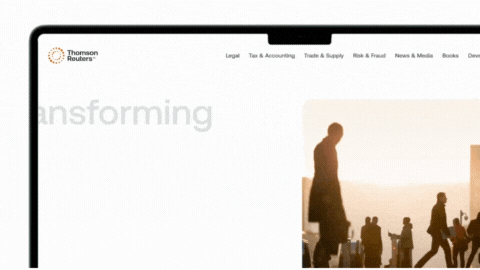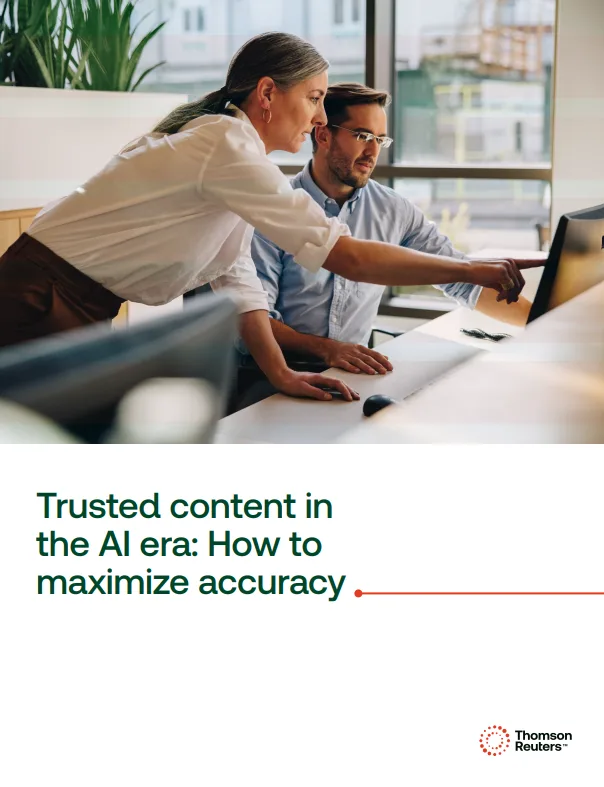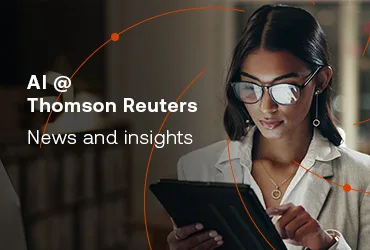Streamlining legal workflows through advanced AI collaboration
Highlights
- Generative AI creates content such as drafts and summaries, while agentic AI executes multi-step tasks. Their combined power enables integrated, end-to-end legal workflows that automate processes from creation to execution.
- Professional-grade AI is essential for legal work, as it surpasses consumer tools by offering domain-specific training, rigorous accuracy, secure integrations, and a human-in-the-loop design to ensure quality and reliability.
- When selecting a legal AI solution, key criteria include transparent workflows, data grounded in legal expertise, robust security compliance, and seamless integration with existing environments such as Microsoft 365.
Artificial intelligence (AI) is reshaping how legal professionals approach their work by augmenting expertise, not replacing it. Among the most impactful developments are two distinct types of AI: generative AI (GenAI), which creates content, and agentic AI, which performs tasks with minimal initial direction.
Jump to ↓
Understanding the differences between GenAI and agentic AI
Why both technologies matter in legal workflows
The benefits of professional-grade AI
What to look for in AI solutions for work
Professional-grade AI in action
Understanding the differences between GenAI and agentic AI
By understanding the capabilities and applications of each of these technologies, legal practitioners can harness their full potential to enhance workflow efficiency, accuracy, and scalability.
GenAI
GenAI is designed to create. It produces content such as text, images, and code, based on user input. Powered by large language models (LLMs), it excels at interpreting natural language and generating human-like text. In legal settings, GenAI can assist with drafting documents, summarizing case law, and conducting initial research. It’s a powerful tool for content generation, but it generally can’t complete work a task at a time.
Agentic AI
By contrast, agentic AI is built to act. It plans and executes multi-step tasks, adapting to dynamic environments and making decisions along the way. Agentic AI can interact with other systems, retrieve data, and complete workflows after being given initial directions, without needing input at every step. In legal practice, this means it can manage tasks such as scheduling meetings or updating case pipelines, all while coordinating with other tools.
This level of autonomy is made possible by a controller or coordinator that understands the domain and can dynamically adjust workflows. If a tool becomes unavailable or new information emerges, the system can reroute the process to maintain progress.
However, agentic AI is not a closed loop. Human oversight is built into its architecture. Legal professionals remain in control by reviewing outputs, approving decisions, and guiding the system’s actions. This ensures that while agentic AI handles execution, professionals retain authority over judgment, strategy, and final outcomes.
In practice, this means agentic AI can take on the operational burden of legal work, while humans focus on the nuanced reasoning and interpersonal aspects that machines cannot replicate.

AI news and insights
Industry-leading insights, updates, and all things AI @ Thomson Reuters
Join community ↗Why both technologies matter in legal workflows
GenAI and agentic AI are most effective when used together. Each amplifies the other’s strengths to support more complete, efficient legal workflows.
Legal work often involves multiple steps. For example, drafting a motion might begin with GenAI producing a first draft based on precedent. Agentic AI can then take over by filing the motion through the appropriate system, notifying relevant parties, and updating internal records. This seamless handoff between creation and execution is where the real value lies.
Here are a few examples of how these technologies work together in practice:
- Case law research: GenAI summarizes relevant cases while agentic AI organizes findings, compares them across jurisdictions, and prepares a report for review.
- Contract analysis: GenAI highlights key clauses and risks while agentic AI compares versions, tracks changes, and updates compliance checklists.
- Client engagement: GenAI drafts proposals or correspondence while agentic AI sends them via CRM, schedules follow-ups, and adjusts project timelines.
This collaboration allows legal professionals to move beyond isolated tasks and toward integrated, end-to-end workflows. It also supports a scalable legal service model, enabling teams to manage a higher volume of matters with improved consistency and reduced administrative overhead.
By combining the creative capabilities of GenAI with the operational intelligence of agentic AI, legal professionals gain a dynamic toolkit that mirrors the fluidity, collaboration, and precision of how legal work gets done.
The benefits of professional-grade AI
While consumer-facing tools offer impressive capabilities, they aren’t built for the demands of legal work. Professional-grade AI solutions are different. They’re designed with domain-specific data, rigorous accuracy standards, and secure integrations that meet the expectations and obligations of legal professionals.
According to the 2025 Generative AI in Professional Services Report, more than 40% of professionals already use publicly available GenAI tools for work, and 95% expect GenAI to be central to their organization’s workflow within five years. Many professionals cited time savings and productivity gains as key benefits.
Professional-grade AI also improves:
- Efficiency. Automating routine tasks frees up time for strategic thinking and client interaction.
- Quality. AI can analyze large volumes of data quickly, reducing human error and improving output.
- Productivity. With AI handling repetitive work, professionals can take on more cases or deepen their focus on complex matters.
What to look for in AI solutions for work
Not every AI tool labeled “agentic” or “legal” meets professional standards. Legal professionals should look for:
- Transparent workflows. Can you see how the AI reaches its conclusions?
- Domain-specific data. Is the AI trained on legal content, not just general web data?
- Security and compliance. Does it meet industry standards such as SOC 2 and GDPR?
- Human-in-the-loop design. Can professionals review and guide the AI’s output?
- Compatibility with your current environment. Does the solution integrate with tools you already use, such as document management systems and Microsoft 365?
- Evaluation benchmarks. Has the AI been tested against industry-relevant benchmarks to ensure the system performs reliably under real-world conditions?
- Scalability and support. Can the solution grow with your firm and is there responsive support and training available?
Red flags include:
- Vague or missing documentation about how the AI works.
- Limited integration capabilities.
- No mention of legal-specific training data or evaluation.
- Lack of user control over outputs or workflow steps.
- No clear policy on data usage or retention.
- Overreliance on a single LLM without verification or grounding.
By evaluating AI tools against these criteria, legal professionals can make informed decisions and choose solutions that truly enhance their workflows instead of adding complexity or risk.
Professional-grade AI in action
The combination of GenAI and agentic AI offers a powerful advantage for legal professionals. By automating content creation and task execution, these technologies streamline workflows, improve outcomes, and free up time for higher-value work.
Professional-grade solutions such as CoCounsel Legal are leading the way. Built for the legal domain, tested for accuracy, and designed to work alongside human expertise, CoCounsel Legal exemplifies how GenAI and agentic AI can work together in a professional-grade platform.
To learn more about how to maximize accuracy in AI-powered legal work, download the white paper: Trusted content in the AI era: How to maximize accuracy














